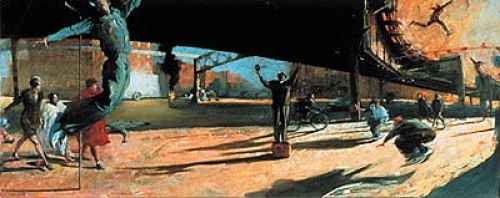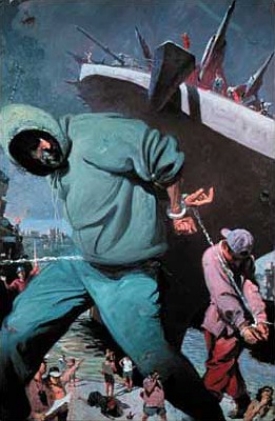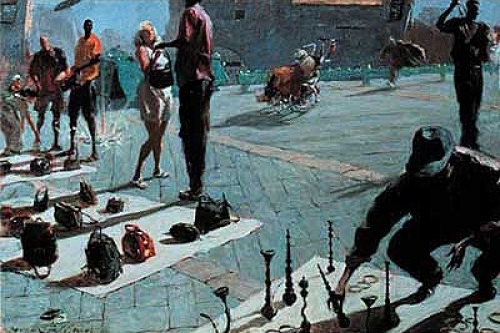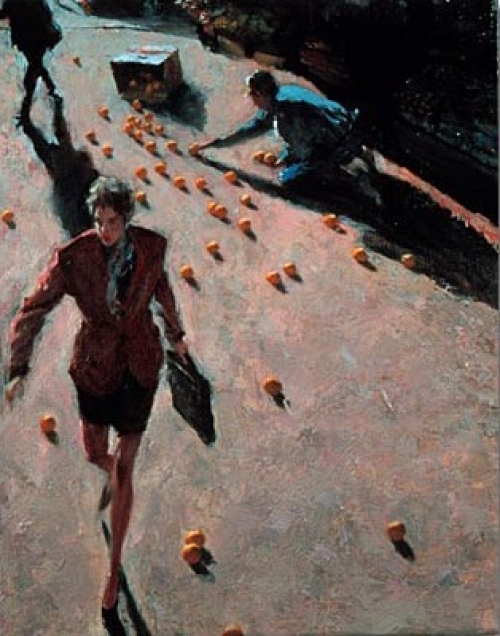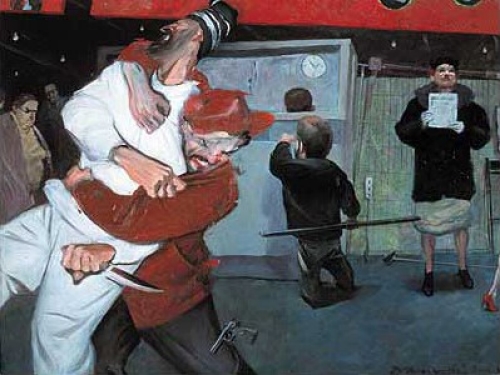Master of urban realism
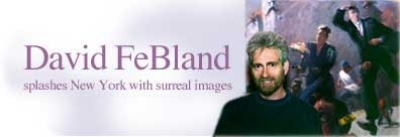
(Article originally published in October 2000)
Stranded with a flat tire in an unfamiliar neighborhood of the Bronx, David FeBland, A&S '71, decided to leave his wife in the rental car and walk to a nearby corner.
That is when it happened. Standing beneath an enormous railroad trestle, he encountered something that moved him deeply. FeBland couldn't shake the images from his mind and would return to that exact spot a year, to the day, later.
Once a political science major at the University of Cincinnati, he is today the New York-based fine artist whom The New York Times has referred to as on "the leading edge of the new urban realists." Though he has no formal background in art and admits that the only time he set foot in a fine arts building at UC was to "hunt for women," FeBland is known for paintings The Washington Post calls "brash, bizarre and beautifully painted oils of life in the Big Apple."
Hanging his show at the Carnegie Visual Performing Arts Center in Covington, Ky., earlier this year, the wiry-haired painter explained how a flat tire in the Bronx led to the piece he titled "Life is Beautiful".
"I was underneath this fabulous 19th-century superstructure," he says, twirling a hammer in his hand. "There was this marvelous sunset that was beginning to take place, and the light just shot through a very small opening between two buildings and flooded this entire area with a fabulous color. It lasted about five minutes, then it was gone.
"I loved it, and I wanted to capture something about that visual language. I waited a full year to return so that the sun would be again in exactly the same spot under the same lighting conditions."
Though ideas rarely incubate for so long, FeBland's creations do tell very specific stories. His work, a critique of urban American culture, often depicts peripheral characters on the outskirts of mainstream society. "They are outsiders looking in, and I'm observing outsiders who are trying to find a way in," he says as he sinks a nail into the gallery wall.
Thugs, street vendors, immigrants and panhandlers get noticed in FeBland's surreal universe, often alongside the rest of the city's dwellers, and yet, somehow, still in a parallel world. His subjects are people he passes on the street every day.
"New York influences my work, but my paintings are not about New York," he explains, a British accent hinting at his upbringing in England before moving to the U.S. at age 6. "They are set in New York as a matter of convenience because that is where I live and work.
"I don't have to walk more than a hundred steps from my door, and I see things that you might have to drive considerable distances for in less dense environments. I've kind of condensed the American cultural phenomenon of the last half of the 20th century into the world outside my studio."
As compelling as that world can be, it is also one he needs to escape. FeBland and wife, Lynda Mandlawitz, A&S '70, who met at UC, travel Europe by tandem bicycle for nearly two months every summer -- a ritual they have followed since 1984.
"We will fly into one city and fly out of another city, and usually they are 100 miles apart," he says. "We only travel by bicycle. We are the space shuttle when we go through some of those towns. They have never seen anything like it."
He brings a sketchbook to keep up on his work, and sometimes what he observes overseas comes to life on canvas. Traveling abroad, FeBland says, gives him perspective, allowing him to inhabit the role his subjects normally inhabit -- the outsider.
"I feel very refreshed at the end of the summer when I come back. I'm usually busting with new ideas. If I don't start working immediately, it vanishes in the visual cacophony of daily living in New York City."
David FeBland gives ample credit to his UC years for helping him to develop his artistic expression. "The way I found myself looking at the world developed very early. For me, my view of the world was pretty much formed by the time I was in my early 20s at UC. It took me another 20 years to find and master the visual language, the language to represent it pictorially."
While at UC, FeBland became interested in the way architecture influenced people's lives. He went on to get a degree in landscape architecture and worked for most of his career as a free-lance illustrator.
In 1990, he rented a studio space and began creating an entirely different type of work -- urban paintings. Ten years later, the change has more than paid off.
"It was a full five and a half years of just learning to experiment and dipping my toe in the water creatively until I felt I had enough of a body of work to show it to anybody," he explains. "I didn't want to go out there half-baked. I wanted to work on my craft. I was developing what it was I had to say and my artistic language."
FeBland connects with subjects who likely will never see his work, or the inside of a gallery for that matter. That was not, however, a cognizant decision.
"At first I was experimenting, and I was grasping, and nothing cohesive was coming on. I was searching for voice. Then I found myself, thematically, going back to certain subjects again and again. The passion made me. I didn't consciously go out to do any of this. I just realized one day that I was working in this area."
He submitted his work to his first show in 1996. "I was very lucky," Febland said. "I got in, I won a prize, and I got some press. That sort of got the ball rolling. That emboldened me to submit work to additional shows. I have been in about 60 shows since then."
Today, it isn't uncommon to find FeBland's paintings for sale for thousands of dollars. Each starts with an idea, an image or an inspiration -- sometimes right after a flat tire.
Links:
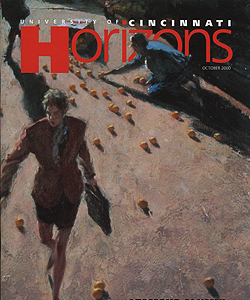
 Past Issues
Past Issues